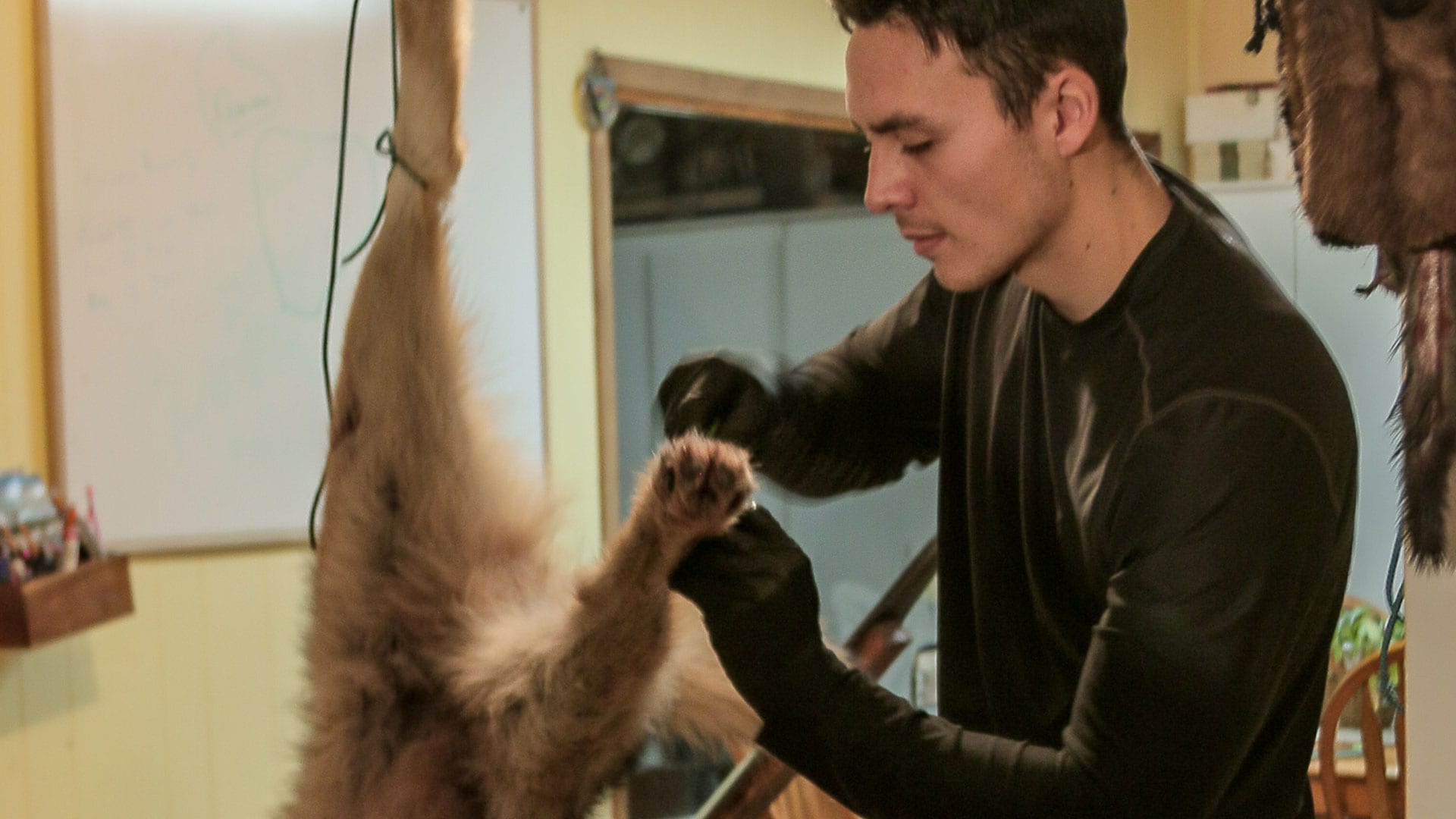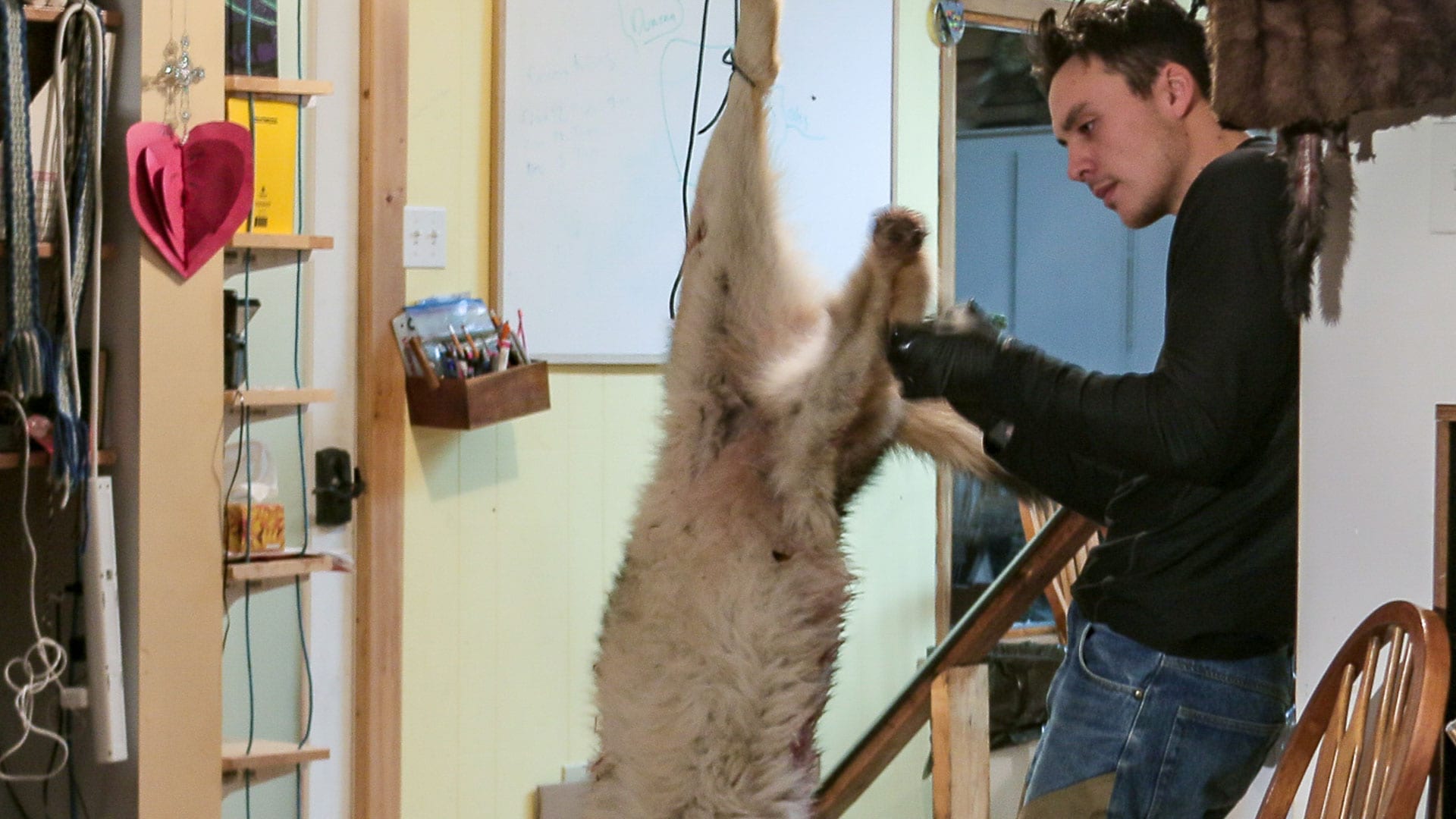Devon Alloloo hangs a tundra wolf from the door frame of his dining room.
It’s from one of his three traps set near the small community of Dettah, a 10-minute drive by ice road from Yellowknife, Northwest Territories (N.W.T.).
“I feel pretty pumped just knowing that I was able to harvest. It’s a lot of work. It’s very time consuming and meticulous – on where the wolf is. It’s not playing by your rules,” Alloloo said.
Alloloo, is Inuk and grew up hunting, but considers himself new to trapping, starting three seasons ago in 2018.
But already he’s sharing his knowledge of trapping wolves by hosting workshops to groups of hunting hopefuls.
“The ethics of trapping is respecting the wildlife and making sure you aren’t causing more harm to animals. Pretty much every trap I use is for immediate death, but if I use a foot trap for wolf I make sure I am on top of my game to check them every day,” he said.

The fur from his latest catch will fetch him upwards of $750 while the carcass will snag $200 as part of N.W.T.’s wolf–harvesting program in place to support the traditional economy and attempt to help declining barren caribou herds.
The wolf cull program is one of many attempts to save the two rapidly declining barren caribou herds
In the last 30 years the kokètì ekwǫ – Bathurst herd has shrunk 98 per cent and conservation efforts like prohibiting all hunting since 2015 have not stopped the decline.
According to the most recent population survey in 2018, the sati ekwò – Bluenose-East herd was halved in just three years, with only 19,000 caribou left.
Hunting tags for that herd are very limited.
Allooloo and conservation groups believe local hunters could and should play a bigger role in reducing wolf populations and slowing the decline of caribou herds.
The Wekʼèezhìi Renewable Resources Board (WRRB), the group responsible for managing the Bathurst and Bluenose-East herds have recommended the territorial government (GNWT) scrap a controversial caribou management program intended to reduce wolf populations.
From January to April 2020, the GNWT ran a one-season aerial wolf cull pilot program where they hired marksmen to shoot wolves from helicopters.
Jody Pellissery, executive director for WRRB told APTN News the resource board does not dispute the need for swift action against caribou predators, but they’ve also produced a whole suite of recommendations for the protection of caribou, including the herd’s habitat management.
“Based on the success of the pilot program, as well as public concern we heard the board made the decision to recommend discontinuing the aerial removal,” Pellissery said. “But continuing the ground based harvest, to offset that need to help the [caribou] herd. It’s more appropriate to have the harvest conducted in that way it’s more traditional and helps to support the families in a subsistence way.”
The report also slammed the territorial government’s current wolf harvesting program for what they saw as a lack investment in hunters who may require training and greater financial supports to do the work.
A little under $60,000 was spent on ground harvest support and incentives proposed by the resource board.
Local hunters harvested 44 wolves in the caribou management zones.
Meanwhile, the aerial cull came with a $320,000 price tag to kill just 36 wolves in the same zone, which works out to be roughly $8,600 per wolf.
APTN asked the territorial department of environment and natural resources (ENR) whether the program costs were appropriate, given the outcomes.
Brett Elkin, assistant deputy minister of operations with the department said based on scientific research, the only way to lessen caribou predation from wolves is to kill a substantial amount of wolves over in a select period of time.
“I think at the end of the day the program was effective, we reached our targets that’s going to help the overall program of caribou recovery and we stayed within our budget so we are confident that it was a good and effective year for the first year,” Elkin said.
ENR said hunters faced challenges in meeting wolf cull quotas, and that areal measures were only used after the hunters could not produce the numbers.
“Weather was a challenge and the wolves were located in very difficult positions for a lot of our harvesters to access them, so by three months of ground base we were only half way to our targets so we went to aerial using experienced crews,” he said.
Read More:
First Nation raises alarm after Yukon opens caribou hunt without herd management plan
Another critique in the WRRB’s report took aim at government approaches to collect data on wolf populations in the territory and the sheer lack of data on northern packs.
When asked whether local data on territorial wolf populations was used in the development of the aerial cull program, Elkin told APTN because of the program’s infancy in the NWT, information from B.C. and Nunavut’s cull programs was studied and applied.
“In doing that evaluation we looked for some of the common principles to caribou and wolf interactions that apply and we also recognized in areas where there could be differences and used basically best principles and best practices to inform what we are doing,” Elkin said.
For Allooloo, hunters have a role in data collection too, but once again, more support will be needed to help new hunters and those living in remote communities.
“If people need access to snowmobiles maybe the government would provide access for locals to use snowmobiles to harvest some program, gas provided, ammunition, and toss them in a position so they know where the wolves are at,” he said.
A response to WRRB recommendations is expected from the territory in mid-February.










